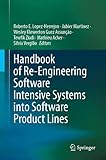Handbook of Re-Engineering Software Intensive Systems into Software Product Lines [electronic resource] /
Material type: TextPublisher: Cham : Springer International Publishing : Imprint: Springer, 2023Edition: 1st ed. 2023Description: XXXII, 517 p. 179 illus., 115 illus. in color. online resourceContent type:
TextPublisher: Cham : Springer International Publishing : Imprint: Springer, 2023Edition: 1st ed. 2023Description: XXXII, 517 p. 179 illus., 115 illus. in color. online resourceContent type: - text
- computer
- online resource
- 9783031116865
- 005.1 23
- QA76.758
Part I. Feature location and variability model extraction -- Chapter. 1. Feature Location in Software Variants Toward Software Product Line Engineering -- Chapter. 2. Feature & Variability Extraction From Natural Language Requirements -- Chapter. 3. Semantic History Slicing -- Chapter. 4. Feature Location in Models (FLiM): Design time and Runtime -- Chapter. 5. Search-Based Variability Model Synthesis from Variant Configurations -- Chapter. 6. Extending boolean variability relationship extraction to multi-valued software descriptions -- Chapter. 7. Machine learning for feature constraints discovery -- Part. II. Reengineering product line architectures -- Chapter. 8. Extraction of Software Product Line Architectures from Many System Variants -- Chapter. 9. ModelVars2SPL: from UML Class Diagram Variants to Software Product Line Core Assets -- Chapter. 10. Extraction and Evolution of a Software Product Line from Existing Web-Based Systems -- Chapter. 11. Re-Engineering Microservice Applications into Delta-Oriented Software Product Lines -- Chapter. 12. Understanding the Variability on the Recovery of Product Line Architectures -- Part III. Frameworks -- Chapter. 13. PAxSPL: A framework for aiding SPL Reengineering Planning -- Chapter. 14. Bottom-Up Technologies for Reuse: A Framework to Support Extractive Software Product Line Adoption Activities -- Chapter. 15. Systematic Software Reuse with Automated Extraction and Composition for Clone-and-Own -- Chapter. 16. Re-engineering Automation Software with the Variability Analysis Toolkit -- Chapter. 17. Managing Software Product Line Evolution by Filtered Editing: The SuperMod Approach -- Part. IV. Perspectives -- Chapter. 18. Challenges and Potential Benefits of Adopting Product Line Engineering in Start-Ups: A Preliminary Study -- Chapter. 19. Re-engineering Legacy Systems as Microservices: An industrial survey of criteria to deal with modularity and variability of features -- Chapter. 20. Evolution in Software Product Lines: An overview.
This handbook distils the wealth of expertise and knowledge from a large community of researchers and industrial practitioners in Software Product Lines (SPLs) gained through extensive and rigorous theoretical, empirical, and applied research. It is a timely compilation of well-established and cutting-edge approaches that can be leveraged by those facing the prevailing and daunting challenge of re-engineering their systems into SPLs. The selection of chapters provides readers with a wide and diverse perspective that reflects the complementary and varied expertise of the chapter authors. This perspective covers the re-engineering processes, from planning to execution. SPLs are families of systems that share common assets, allowing a disciplined software reuse. The adoption of SPL practices has shown to enable significant technical and economic benefits for the companies that employ them. However, successful SPLs rarely start from scratch, but instead, they usually start froma set of existing systems that must undergo well-defined re-engineering processes to unleash new levels of productivity and competitiveness. Practitioners will benefit from the lessons learned by the community, captured in the array of methodological and technological alternatives presented in the chapters of the handbook, and will gain the confidence for undertaking their own re-engineering challenges. Researchers and educators will find a valuable single-entry point to quickly become familiar with the state-of-the-art on the topic and the open research opportunities; including undergraduate, graduate students, and R&D engineers who want to have a comprehensive understanding of techniques in reverse engineering and re-engineering of variability-rich software systems.


There are no comments on this title.